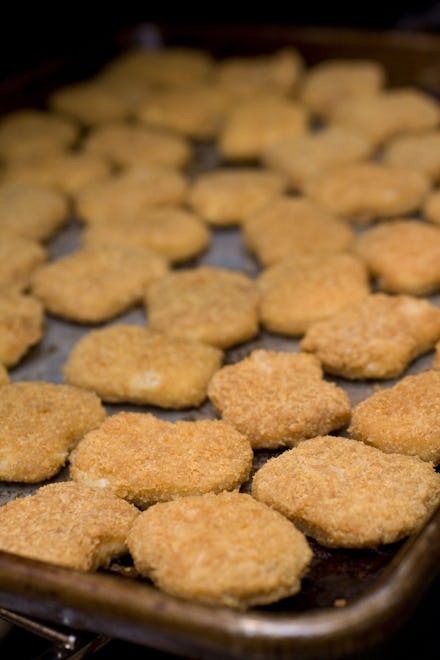How are chicken nuggets made? Not with pink slime, it turns out

Like many a mystery meat, chicken nuggets are a questionable delicacy. While drumsticks, wings, thighs and even feet are recognizable parts of a fried chicken, a nugget leaves an air of obscurity. What is it made of? Where did it come from? How are chicken nuggets even made?
In effort to be more transparent about their food, McDonald's published a video in 2014 that shows the production process of its McNuggets.
According to the video, whole chickens are deboned and the breast meat is separated. The breast meat is then ground and added to a blender with a mix of seasonings and chicken skin, which acts as a natural binder and is said to add flavor.
Next, the chicken mixture is molded into four signature McNugget shapes: the ball, the bell, the boot and the bowtie. The shapes are coated in a light batter and then coated again in a thicker tempura batter.
Double-breaded nuggets are par-fried at the factory, which sets the batter but keeps the chicken raw until it's fully fried at the restaurant.
"We don't know what [pink slime] is or where it came from, but it has nothing to do with our Chicken McNuggets," Nicoletta Stefou, supply chain manager at McDonald's Canada, told Business Insider in May. In 2012, McDonald's, Burger King and Taco Bell pledged to stop using the ingredient that is often referred to as this "pink slime," Snopes, a fact-checking website, reported. While the ground chicken in the video isn't necessarily pink, it still looks like a questionable raw meat goop.
Later, YouTube user Ed Stein visited a Tyson plant where McNuggets are made and recorded a similar process.
Tom Super, a spokesman for the National Chicken Council, confirmed that the above video — in which chicken breasts are ground, mixed with chicken skin and "marination" i.e. sodium phosphates, food starch and salt and then shaped and fried — is representative of pretty much how all mass-produced chicken nuggets are made, though seasonings, shapes and breading may vary.
In contrast to the ground-up mass-produced chicken phenomenon, organic nuggets take a different, non-mushed meat approach — at least, at Bay Area-based Hip Chick Farms. The organic, frozen poultry company is run by Serafina Palandech and her wife, chef Jennifer Johnson, a former sous chef. Johnson, who is slated to cook for President Barack Obama before he leaves the White House, makes Hip Chick's all-natural nuggets without any of the mysterious ground chicken pieces.
To make the Hip Chick's nuggets, organic, free-range, hormone-free chicken is chopped against the grain, seasoned, soaked in organic buttermilk and then dredged in organic panko breadcrumbs before the chicken pieces are fried. After frying, the nuggets are flash frozen and eventually packaged for sale. The process looks a lot more like how you would cook at home: no fillers, stabilizers, starch or binders are added in. See: McNuggets.
"Typically, conventional chicken nuggets are made with mechanically separated chicken — using the bits and parts that are not sellable of a chicken carcass," Johnson said in an email. "Approximately, a mass produced chicken nugget has 50% meat and the rest is fat, ground bone, blood vessels and connective tissues. This mix does not generally taste very good or taste like chicken, so then the manufacturers add salt, sugar, starch, binders and fillers to make it taste like palatable."
A 2013 study by Dr. Richard deShazo, a professor of pediatrics and medicine at the University of Mississippi Medical Center, showed that some fast-food nuggets were only 50% meat, stuffed with fat, blood vessels, nerve, connective tissue and ground bone. Claims of 100% white meat by restaurants aren't necessarily false if the small percentage of meat is, in fact, only white meat.
"Beyond the additives and fillers, many chicken nuggets are made from chickens raised using antibiotics, and GMO feed," Johnson said, which she believes are not great for human ingestion.
"All that goes into the chicken, goes into you," Johnson said. "We feel strongly that this is not good for the health of our kids or our environment. Taking the time and investing the money into doing it [our] way is much more difficult than mass producing a typical nugget."
The tasty, healthier results are well worth it to many. "We believe in transparency, compassion and trust," Johnson said. "We are determined to do that right thing and make it available for as many people as possible."
• Sept. 9, 2016, 3:59 p.m.: This story has been updated.